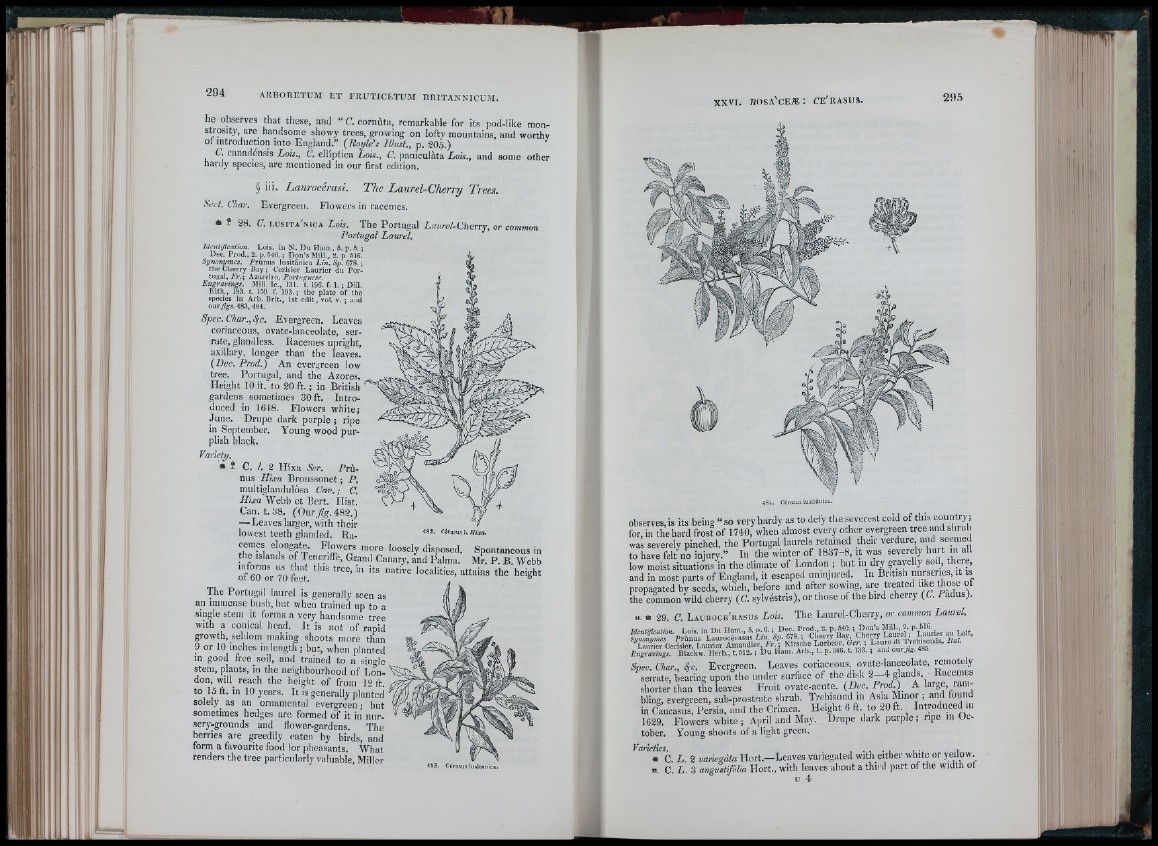
he observes th a t these, and “ C. cornuta, remarkable for its pod-like monstrosity,
are handsome showy trees, growing on loftv mountains, and worthy
ot introduction into England.” {Royle’s Illust., p. 205.)
C. canadénsis Lois., C. elliptica Lois., C. paniculàta Lois., and some other
hardy species, are mentioned in our first edition.
§ iii. Laurocèrasi. The Laurel-Cherry Trees.
Sert. Char. Evergreen. Flowers in racemes.
• Í 3 8 . C. l u s i t a ' n i c a Lois. The P o rtu g al Laurel-Cherry, or common
Portugal Laurel.
Identification. Lois, in N . D u Ham,, 5. p. .5. ;
Dec. Prod., 2. p. .540.; D o n ’s Mill., 2. p. .516.
Synonymes. FrAn u s iusitanic a L in , Sp. 678.;
th e C h e rry Bay ; Cerisier L a u rie r du P o rtu
g al, Fr.; Azareiro, Fortoguess.
Engrauings. Mill. Ic., 131. t, 196. f. 1. ; Dill.
E lth ., 193. t. 169. r. 193.; th e p la te o f t h e
species in Arb. B rit., 1st edit., vol. v. ; and
oar figs. 483,484.
Sp ec . Char., Sfc, Evergreen. Leaves
coriaceous, ovate-lanceolate, serrate,
glandless. Racemes upright,
axillary, longer than the leaves.
(Dec. Prod.) An evergreen low
tree. Portugal, and th e Azores.
Height 10 ft. to 20 f t . ; in British
gardens sometimes 30 ft. In tro duced
in 1618. Flowers w h ite ;
Ju n e . Dru p e dark purple ; ripe
in September. Young wood purplish
black.
Variety.
'• i C. /. 2 H ix a Ser. Pru-
mis H ira B ro u s so n e t; P .
multiglandulosa C a v . C .
Hixa Webb et Bert. Hist.
Can. t.3 8 . (O u ry fg .482.)
— Leaves larger, with their
lowest teeth glanded. Ra-
cemes elongate. Flowers more loosely tiisposed. Spontaneous in
the islands o f Teneriffe, Grand Canary, and Palma. Mr. P . B. Webb
o f 6™or TOflftt foe ‘'e 'g h t
The Portugtil laurel is generally seen as
an immense bush, but when trained up to a
single stem it forms a very handsome tre e
with a conical head. I t is n o t o f rapid
growth, seldom making shoots more than
p or 10 inches in length ; but, when planted
in good free soil, and trained to a single "<
stem, plants, in th e neighbourhood o f Lon-
don, will reach the hei»ht o f from 12 ft.
to 15 ft. in 10 years. I t is generally p lanted
solely as an ornamental e v erg re en ; but
sometimes hedges are formed o f it in ntir-
sery-grounds and flower-gardens. The
berries are greedily eaten by birds, and
form a fiivourite food for pheasants. What
renders the tree particularly valuable, Miller
4 8 2 . Cérasus 1, H ix a .
484. Céraaus lu s itán ic a .
observes, is its being “ so very hardy as to defy th e severest cold o f this country ;
for, in the hard frost o f 1740, when almost every o th e r evergreen tre e and shrul
wa! severely pinched, the P o rtu g al laurels retained their verdure and seemed
to have felt no injury.” In th e winter o f 1837-8, it was severe y h u rt m all
low moist situations in th e climate o f London ; b u t m dry gravelly soil, tht^re
and in most parts o f England, it escaped u n in ju r e f In British nursenes. it is
propagated by seeds, which, before and after sowing, are treated like tho e ot
the common wild cherry (C. sylvéstris), o r those o f th e bird cherry (C. P ad u s).
«- « 29. C. L a u i i o c e ' b a s u s Lois. Tlie Laurel-Cherry, or common Laurel.
Engravings. Blackw. H e rb., t. 51 2 .; D u H am . Arb., l.p .3 4 6 . 1 .133. j and o u rJ 15. 4«a.
Spec. Char., 4c. Evergreen. Leaves coriaceous, ovate-lanceolate, remotely
serrate, bearing upon th e unde r surface o f th e disk 2—4 glands. I^^cemes
shorter than th e leaves F ru it ovate-acute. (Dec. P t y d ) A large, rambling,
evergreen, sub-prostrate shrub. Trebisond m Asia Minor ; and found
in Caucasus, Persia, and the Crimea. Height 6 ft. to 20 ft. Intro d u ced in
1629. Flowers w h ite ; April and May. Drupe dark p u rp le ; n p e m Oc-
tober. Young shoots o f a light green.
Varieties. . , . , i • i
* 0 . L. 2 vaiiegdta H o rt.—Leaves variegated with either white or yedow.
tL C. -L. 3 angustifolia H o rt., with leaves about a third jiart ol the width ot
u 4